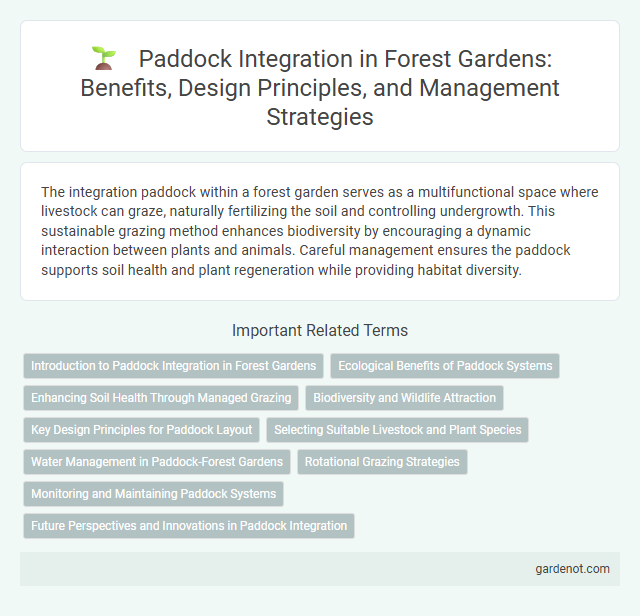The integration paddock within a forest garden serves as a multifunctional space where livestock can graze, naturally fertilizing the soil and controlling undergrowth. This sustainable grazing method enhances biodiversity by encouraging a dynamic interaction between plants and animals. Careful management ensures the paddock supports soil health and plant regeneration while providing habitat diversity.
Introduction to Paddock Integration in Forest Gardens
Integration paddocks in forest gardens serve as multifunctional spaces where livestock manages undergrowth while enriching soil fertility through natural manure deposition. These paddocks enhance biodiversity by supporting native plant species and promoting symbiotic relationships between animals and perennial crops. Efficient paddock integration optimizes nutrient cycling, reduces weed pressure, and improves overall ecosystem resilience in sustainable agroforestry systems.
Ecological Benefits of Paddock Systems
Integration paddock systems in forest gardens enhance biodiversity by providing diverse habitats for pollinators, birds, and beneficial insects, which improve overall ecosystem health. These systems promote soil fertility through natural nutrient cycling and reduced erosion via continuous ground cover and organic matter inputs. Water retention and microclimate regulation within paddocks support resilient plant growth and contribute to sustainable land management.
Enhancing Soil Health Through Managed Grazing
Integration paddocks in forest gardens use managed grazing practices to improve soil health by promoting nutrient cycling and enhancing microbial activity. Rotational grazing within these paddocks supports organic matter decomposition and increases soil fertility, leading to robust plant growth. Strategic livestock movement prevents overgrazing, reduces soil compaction, and fosters a balanced ecosystem.
Biodiversity and Wildlife Attraction
Integration paddocks within forest gardens enhance biodiversity by creating diverse habitats that support various wildlife species, including pollinators, birds, and beneficial insects. The mix of native plants, shrubs, and trees in these paddocks encourages natural pest control and promotes ecological balance. This strategic design boosts ecosystem services, fostering resilient and thriving forest garden environments.
Key Design Principles for Paddock Layout
Designing an integration paddock in a forest garden emphasizes maximizing plant diversity and animal access while maintaining soil health through rotational grazing patterns. Key design principles include strategic placement of shade-tolerant species alongside sun-loving plants to optimize microclimates and enhance nutrient cycling. Water management features such as swales or ponds are integrated to support both flora and fauna, promoting resilience and productivity in the paddock system.
Selecting Suitable Livestock and Plant Species
Selecting suitable livestock and plant species for an integration paddock in a forest garden requires understanding their complementary roles in nutrient cycling and pest control. Animals such as chickens or goats can help manage undergrowth and fertilize the soil, while nitrogen-fixing plants like clover or lupine enhance soil fertility and support diverse plant growth. Choosing species adapted to local climate and soil conditions maximizes ecosystem resilience and productivity in the integrated paddock system.
Water Management in Paddock-Forest Gardens
The integration paddock in forest gardens utilizes contour swales and strategically placed ponds to capture and retain rainwater, enhancing soil moisture and reducing erosion. Deep-rooted perennial plants in the paddock improve infiltration and nutrient cycling, promoting a resilient micro-ecosystem that supports diverse plant and animal species. Efficient water management in paddock-forest gardens increases productivity and sustainability by mimicking natural hydrological patterns.
Rotational Grazing Strategies
Integration paddocks enhance forest garden productivity by implementing rotational grazing strategies that optimize soil health and plant diversity. Rotational grazing cycles livestock through designated sections, preventing overgrazing and promoting nutrient distribution, which supports tree growth and understory vegetation. This method balances animal impact with ecosystem sustainability, fostering a resilient agroforestry system.
Monitoring and Maintaining Paddock Systems
Regular monitoring of integration paddocks in forest gardens ensures optimal plant health and soil quality, enhancing biodiversity and productivity. Maintaining paddock systems involves managing grazing intensity, controlling invasive species, and assessing nutrient cycling to support sustainable agroforestry practices. Implementing adaptive management strategies based on continuous observation promotes resilience and long-term ecosystem stability.
Future Perspectives and Innovations in Paddock Integration
Future perspectives in paddock integration emphasize the use of advanced agroforestry techniques and precision technologies to enhance biodiversity and soil health within forest gardens. Innovations include the deployment of smart sensors and data analytics for real-time monitoring of soil moisture, nutrient cycling, and plant growth, optimizing resource use efficiency. Integrating silvopastoral systems with automated livestock management tools promises to improve animal welfare while maintaining ecosystem balance and carbon sequestration.
Integration paddock Infographic

 gardenot.com
gardenot.com